Earlier this month Wine Lister published its annual Bordeaux Market Study, and in recent weeks we’ve published a few nuggets from the 48-page long study on this blog (such as the top-scoring Bordeaux crus, and how to arrive at a 2016 release price). Today, we’re going to explore the popularity of Bordeaux’s individual appellations by looking at the online search frequency from our data partner Wine-Searcher for the six most popular wines of each.
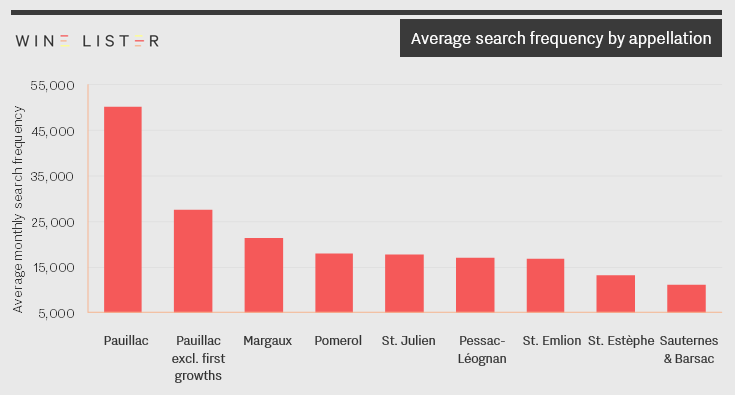
Unsurprisingly, Pauillac – home to three of the five first growths – leads the way, with well over double the number of searches as nearest rival Margaux. If we exclude Châteaux Lafite, Mouton and Latour, the Pauillac average is just under 27,500 searches per month, still 29% ahead of Margaux.
Pomerol comes third, defying low production levels to achieve more average searches for its top wines than Saint-Julien. Pessac-Léognan benefits from the inclusion of Haut-Brion to help it edge ahead of Saint-Emilion, in spite of the latter’s four premiers grands crus classés A, while Saint-Estèphe and Sauternes & Barsac bring up the rear.
This is just a taster of the 2017 Bordeaux Market Study. You can download the full 48-page report from the Wine Lister Analysis page (subscribers only).
With the latest data now in from Wine Searcher, we took a look at which wines have seen their average monthly searches soar in the last month. The US boasts two wines in this top 5, with searches continuing to increase for Screaming Eagle, and Scarecrow seeing a significant uptick. Bottled relatively recently, Scarecrow 2014 scored 96+ from our US partner critic Antonio Galloni, who described it as “a wine of finesse.” At the end of February, Scarecrow 2014 was the top lot in a Premiere Napa Valley auction, selling for $200,000. The increase in searches has boosted Scarecrow’s Brand score from 868 to 885.
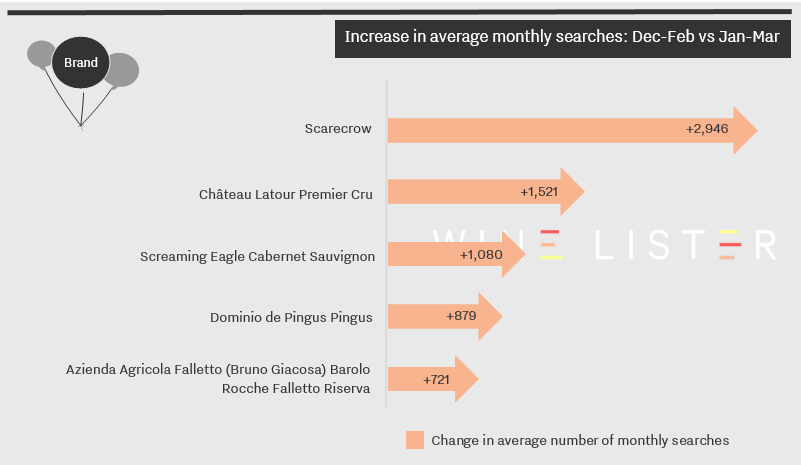
Latour was the only wine from France to see its popularity rise last month, with searches for the Bordeaux first growth no doubt increasing as a result of the ex-château release in mid-March of Latour 2005, for €670 per bottle ex-négociant. Latour has the highest Brand score of all the wines in the table, with a near-perfect 999.
The final two wines to have seen a rise in popularity are Spain’s Pingus, whose 2014 recently received a 100-point score in the Wine Advocate, and Italy’s Azienda Agricola Falletto (Bruno Giacosa) Barolo Rocche Falletto Riserva. In March, Antonio Galloni praised “the genius of Bruno Giacosa” in a vertical tasting, and the increase in searches resulted in the wine’s Brand score rising from 812 to 822.
How is the popularity score calculated and how does it fit into the overall Wine Lister score?
In the second blog exploring some of the findings from Wine Lister’s Tuscany Market Study – following on from our look at how the region ranks globally – we take a look at the popularity of Tuscany’s appellations. The chart below plots the average number of online searches received each month by the 50 wines in this study (based on data from Wine-Searcher), filtered by appellation.
Wines from Bolgheri DOC are by far the most popular amongst consumers, with, on average, more than twice the number of searches than their nearest competitor, Tuscany IGT. They are boosted by internationally established Super Tuscan brands such as Sassicaia and Ornellaia, which have stolen the limelight from more traditional neighbouring DOCGs such as Brunello and Chianti.
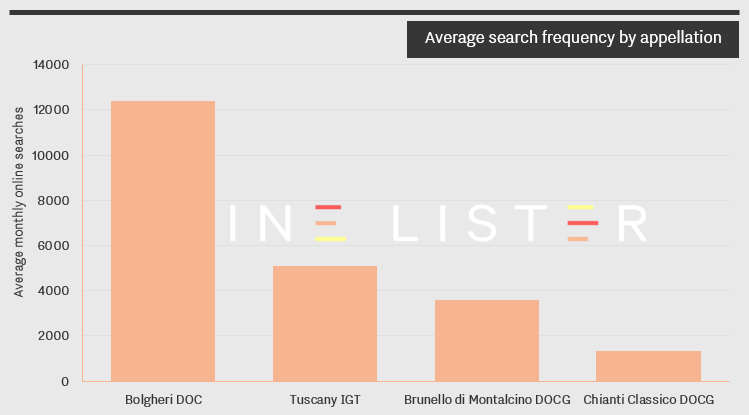
However, perception of each appellation’s popularity tells a different story. At the end of 2016, Wine Lister asked key members of the international fine wine trade about the relative popularity of Tuscan appellations amongst their clientele. Brunello di Montalcino – the third most searched for appellation – came out on top, with nearly 60% of respondents stating that it was very popular with their customers, followed by Chianti Classico.
Tuscany IGT and Bolgheri DOC trail slightly behind, emphasising that it has been the wines themselves, rather than the appellations, that have achieved fame.
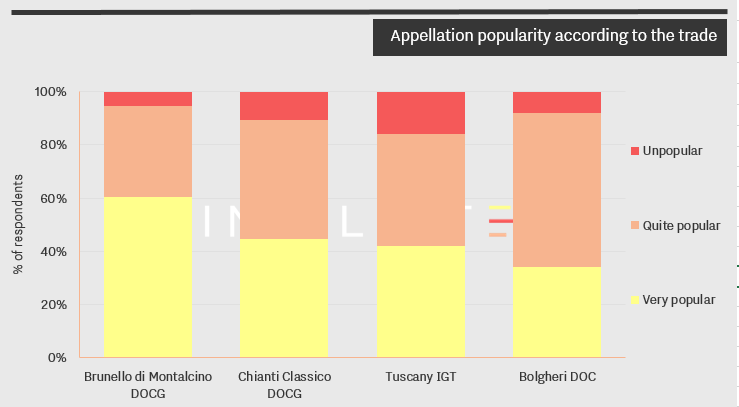
In our final blog post on the Tuscany Market study we will focus in on the individual wines themselves: the trade’s view on which are the region’s consistent sellers and which are its rising stars. Wine Lister subscribers can read the full 35-page report here.
We’ve updated Wine Lister scores to incorporate the latest search frequency data from Wine-Searcher. The higher the relative search frequency of a wine, the higher the popularity score and consequently the better the wine’s Brand score.
The chart below shows the impact of the new online search data on Brand scores, showing the top five biggest gainers.
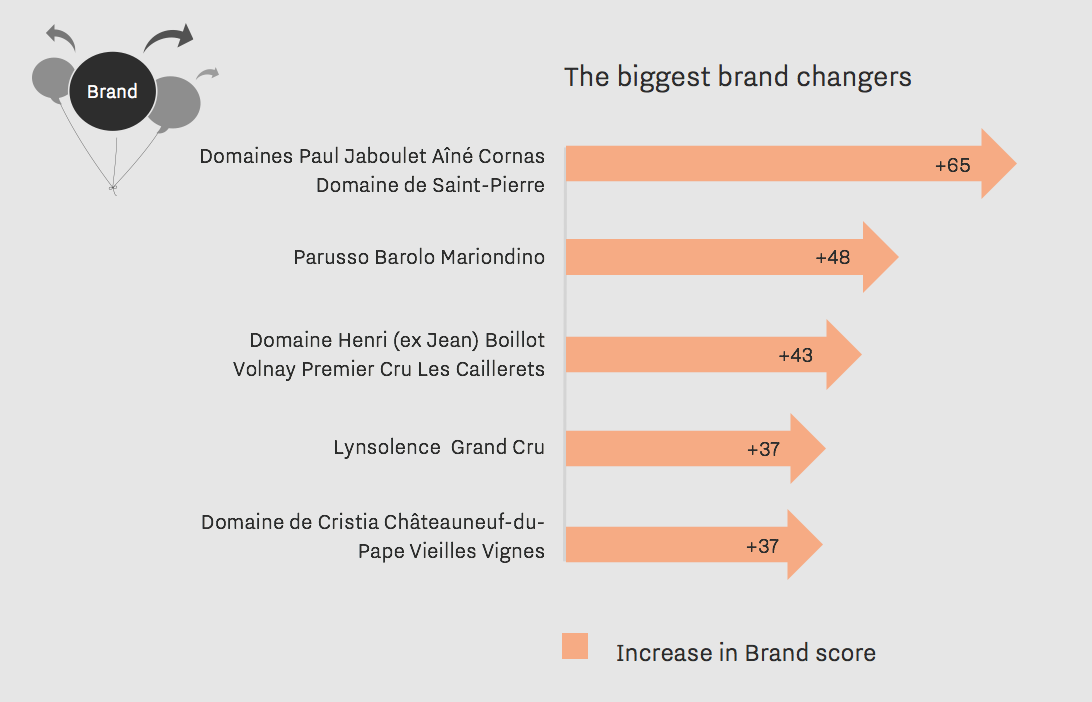
The brands on the rise in November were spread between several regions, with only the Rhône boasting two in the top five. Gaining most in terms of online searches month on month was Domaines Paul Jaboulet Aîné Cornas Domaine de Saint-Pierre. This saw a recent surge in average monthly searches, from 278 average monthly searches in the three-month period up to the end of October, to 639 now. This resulted in its brand score increasing by 65 points, up to 584 /1000.
Parusso Barolo Mariondino searches also increased substantially in the same period, from 140 to 270, taking its brand score to 434 – still below the average brand strength for wines on Wine Lister.
The Wine Lister Brand score algorithm has two components: Distribution and Popularity. The former criterion measures a wine’s presence in the world’s top restaurant wine lists. The latter measures the number of searches for each wine on the world’s most visited wine website Wine-Searcher, our Popularity Partner. We look at the number of times the wine is searched for over a rolling three-month period, and compare this to search frequencies of all other wines. The higher the relative search frequency, the higher the Popularity score.
Our latest score update includes updated Wine-Searcher data for October. The chart below shows the impact of new search data on Brand scores, showing the five biggest gainers:
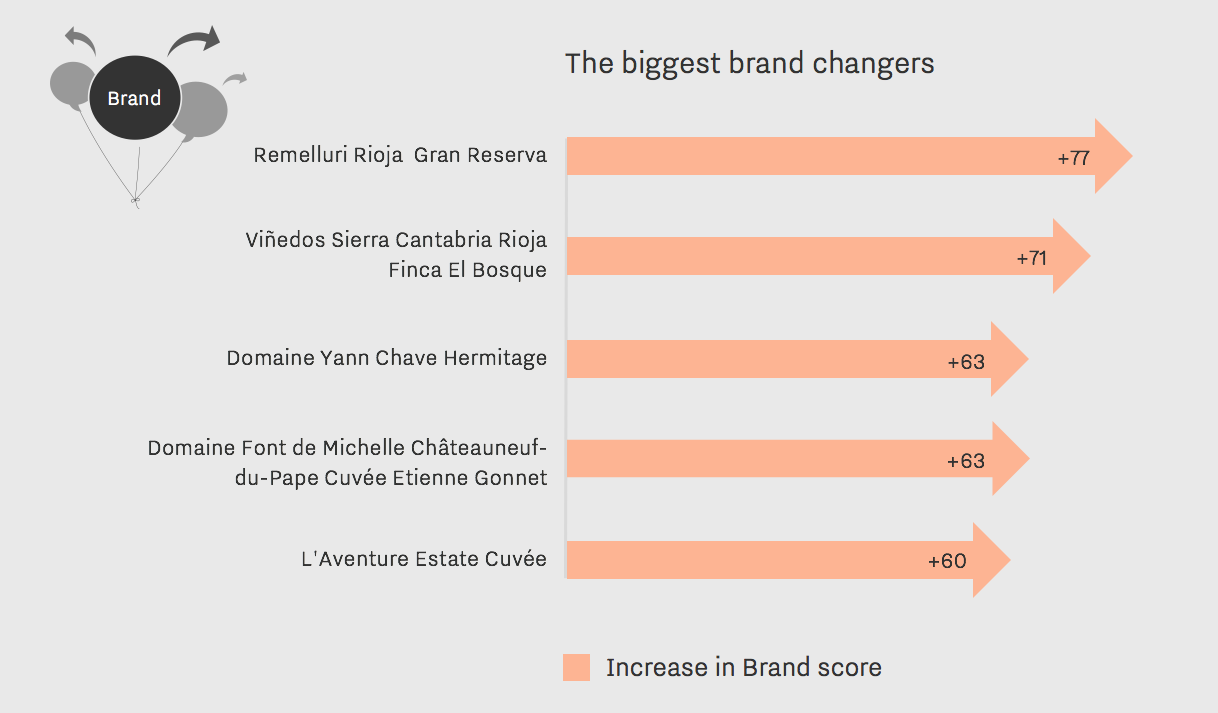
Rioja and the Rhône come out top. The largest gain in Brand score is for Remelluri Rioja Gran Reserva which has seen a considerable surge in user searches (322 monthly searches compared to 172 before the update), as has fellow Rioja, Viñedos Sierra Cantabria Finca El Bosque. In third and fourth place are two wines from the Rhône Valley: Domaine Yann Chave Hermitage and Domaine Font de Michelle Châteauneuf-du-Pape Cuvée Etienne Gonnet. The fifth biggest gainer in Brand terms is Californian adventurer, L’Aventure Estate Cuvée.





